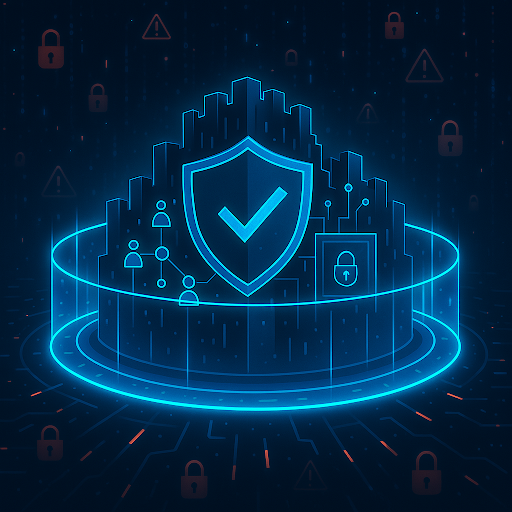Data breaches continue to pose significant cybersecurity risks, leading to financial losses and reputational harm for organizations across the globe. Implementing robust Identity and Access Management (IAM) practices is one of the most effective strategies for mitigating these threats. By enforcing strong authentication protocols and granular access controls, IAM ensures that only authorized individuals can access sensitive information, reducing the likelihood of unauthorized breaches.
The Role of IAM in Preventing Data Breaches
Unauthorized access, weak authentication protocols, and excessive user privileges often lead to security incidents. IAM mitigates these risks by implementing security policies designed to protect user identities and access rights. Key IAM defenses include:
- Multi-Factor Authentication (MFA): Strengthens authentication by requiring multiple verification methods beyond passwords.
- Role-Based Access Control (RBAC): Limits user access to the minimum necessary for their role, following the Principle of Least Privilege (PoLP).
- Continuous Monitoring: Detects anomalies in login attempts and access behaviors before attackers can exploit vulnerabilities.
These security measures help organizations maintain the integrity and confidentiality of their digital assets.
Key IAM Failures Exploited in Recent Breaches
Despite IAM’s effectiveness, poor implementation can create security gaps. Cybercriminals frequently exploit IAM failures, including:
- Credential Compromise: Stolen or weak credentials remain one of the most common entry points for attackers. Even security vendors have suffered breaches due to compromised login information.
- Inadequate Identity Lifecycle Management: Many organizations fail to deactivate accounts when employees leave or change roles. These “orphaned accounts” provide persistent backdoors for attackers.
- Excessive Standing Privileges: Granting indefinite access rights increases the attack surface. PoLP is often recognized but poorly implemented.
- Manual Certification Processes: Traditional access reviews tend to become ineffective “rubber-stamp” exercises due to overwhelming workloads and technical complexities.
Identifying and eliminating these IAM vulnerabilities is critical for maintaining security.
The Impact of Data Breaches on IAM Strategies
Major breaches force organizations to re-evaluate IAM frameworks. The key takeaways from recent incidents include:
- Increased Scrutiny on Authentication: Weak passwords and authentication methods contribute to breaches. Organizations are increasingly adopting MFA and exploring passwordless authentication methods.
- Emphasis on Least Privilege and Just-in-Time (JIT) Access: Over-privileged accounts increase risk, prompting organizations to implement JIT access, granting permissions only when necessary.
- Automated Lifecycle Management: Manual provisioning processes often lead to orphaned accounts. Automation ensures timely access modifications, reducing lingering security gaps.
- Centralization and Unified IAM Platforms: Managing identities across multiple, disconnected systems creates complexity. Organizations now prioritize IAM consolidation for better visibility and control.
- Continuous Monitoring and Auditing: As static access policies are insufficient, there is now emphasis on real-time monitoring which detects anomalies early.
- Shift Towards Zero Trust Security Model: The principle of “trust no one, always verify” is becoming the norm, enforcing stricter identity validation.
Adapting IAM strategies in response to breaches strengthens resilience against future threats.
Effective IAM Strategies and Modern Solutions
To mitigate security risks, organizations must incorporate the following IAM best practices:
- Multi-Factor Authentication (MFA): Mandatory implementation across critical systems adds a crucial security layer, preventing unauthorized access.
- Principle of Least Privilege (PoLP) & Just-in-Time Access: Limit user permissions to only what is necessary, and grant elevated access on a temporary basis to reduce attack vectors.
- Automated Identity Lifecycle Management: Ensure access rights are dynamically updated based on HR events to prevent orphaned accounts.
- Centralized IAM Platforms: Unified IAM systems simplify administration and improve security visibility. Single Sign-On (SSO) solutions enhance usability while maintaining strong authentication.
- Zero Trust Security Model: Implement strict verification protocols for every access request, regardless of origin.
- Privileged Access Management (PAM): Protect high-risk administrator accounts with enhanced security measures, including credential rotation and session monitoring.
- AI-Powered Continuous Monitoring: Use machine learning to detect suspicious activity, prioritize risk-based access reviews, and provide security insights.
- Strong Password Policies & Passwordless Authentication: Enforce unique, complex passwords while transitioning to biometric-based authentication and hardware security keys.
- Regular Security Awareness Training: Educate employees about phishing attacks, credential security, and access control hygiene.
- Incident Response Planning for IAM Breaches: Organizations must prepare an IAM-specific incident response plan detailing containment, forensic investigation, and remediation procedures.
By implementing these modern IAM solutions, organizations can significantly reduce data breach risks and fortify their cybersecurity posture.
Protecting What Matters
Identity and Access Management is no longer just about convenience—it is a critical cybersecurity defense against evolving threats. With IAM failures frequently exploited in major breaches, organizations must prioritize strong authentication, access control, automation, and continuous monitoring to minimize risks. This proactive defense minimizes risks, secures critical assets, and ensures resilience against unauthorized access.
For expert guidance on cybersecurity best practices, our team is ready to help you defend against data breaches.
